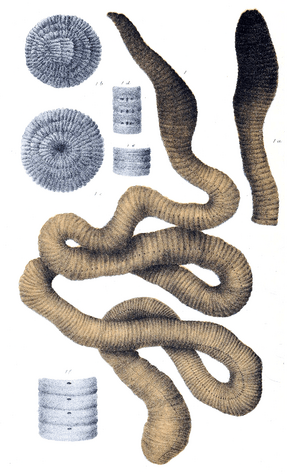Giant Gippsland earthworm facts for kids
Quick facts for kids Giant Gippsland earthworm |
|
|---|---|
 |
|
| Conservation status | |
| Scientific classification | |
| Kingdom: | |
| Phylum: | |
| Subclass: | |
| Family: |
Megascolecidae
|
| Genus: |
Megascolides
|
| Binomial name | |
| Megascolides australis |
|
The giant Gippsland earthworm (Megascolides australis) is a super-long worm from Australia. It's one of about 1,000 native earthworm species found there. These amazing worms can grow to be really big! They usually average about 100 cm (1 meter) long. They are also about 2 cm wide. Some have even been found to be 3 m long.
It's tricky to measure their exact length because they can stretch out. So, scientists often weigh them instead to guess their size. An adult worm usually weighs around 200 grams. They have a dark purple head and a blue-gray body.
Contents
Discover the Giant Gippsland Earthworm
What Makes Them Special?
The giant Gippsland earthworm is truly unique. It's one of the longest earthworms in the world! Imagine an earthworm as long as a car or even longer. Their huge size makes them stand out from other worms.
They also make gurgling sounds when they move through their burrows. This sound can sometimes be heard from above ground. It's like the sound of water draining from a bathtub.
Where Do They Live?
These special worms live only in a small part of Australia. You can find them in the Bass River Valley. This area is in South Gippsland, near towns like Korumburra and Warragul.
Their home is a tiny area, only about 100,000 hectares. They prefer to live in small patches of blue-grey clay soil. This soil is usually close to water sources. They dig burrows about 500mm (half a meter) deep. Some of their tunnels can go as deep as 1.5 meters underground.
Why Are They Vulnerable?
Giant Gippsland earthworms used to live in tall eucalyptus forests. But much of this land has been cleared for farming. Even though their habitat changed, the worms have survived. This is because they live deep underground.
However, these changes have made them a vulnerable species. This means they are at risk of disappearing forever. Their slow growth and reproduction also make them vulnerable.
Life Cycle and Reproduction
These worms have a very slow life cycle. A female worm lays only one egg at a time. This egg is quite large, between 4 and 7 cm in size.
It can take a whole year for a single egg to hatch. After hatching, the young worms take several years to grow into adults. Only then can they start to reproduce themselves. This slow rate of growth and reproduction means it takes a long time for their numbers to increase. This is another reason why they are a vulnerable species.


